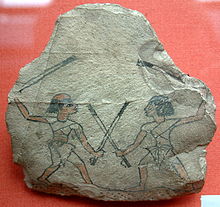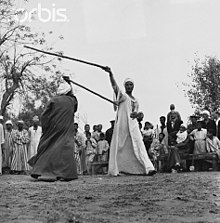Tahtib
The oldest traces of tahtib were found on engravings from the archaeological site of Abusir, an extensive necropolis of the Old Kingdom period, located in the south-western suburbs of Cairo.
On some of the reliefs of the Pyramid of Sahure (V dynasty, c. 2500 BC);[9] the images and explanatory captions are particularly precise and accurate in their depiction of what seems to be military training using sticks.
Three of the 35 tombs of the Beni Hassan necropolis (XI-XII Dynasties, 1900 – 1700 BC) near the town of Minya,[10] contain engravings showing scenes of tahtib.
Similar engravings can be seen in the archaeological site of Tell el Amarna (XVIII Dynasty, 1350 BC),[11] some 60 km south of Minya.
As with its combative counterpart, the dance form of tahtib was originally performed by men, but female versions were later developed.
[13] The right hand uses a heavier stick with a hooked head to beat out the dum (the deep sound from striking the center of the drum) which drive the heartbeat of the rhythm, while the left hand uses a light twig as a switch to produce rapid-fire staccato "taks" (the higher sound from striking the edge of the drum).


